Guides
How to Grow and Care for Pakistan Mulberry: A Complete Guide
Have you ever dreamed of stepping into your garden in the early morning, reaching up, and picking long, ruby-red mulberries that taste like sweet honey straight off the tree? If so, the Pakistan mulberry (Morus macroura) might be exactly what you’ve been searching for. With its lush green foliage and generous yields of juicy fruits, this fast-growing tree is a treasure for any gardener hoping to grow their own fresh, nutrient-rich snacks at home.
But how do you plant it, care for it, and keep it producing baskets of mulberries year after year? Whether you’re a first-time fruit grower or an orchard veteran, this guide will walk you through everything you need to know to grow Pakistan mulberry successfully and confidently.
Let’s dive in and bring your edible garden dreams to life!
What is Pakistan Mulberry?

Pakistan mulberry is a deciduous tree native to the Himalayan foothills, loved by gardeners worldwide for its extra-long (up to 4 inches), sweet fruits with a rich honey-like flavor. Unlike common black mulberries, its berries have minimal acidity, making them perfect for snacking straight from the tree without any sourness.
Pakistan mulberry offers exceptional fruit quality, producing berries as long as your fingers, each one bursting with rich, honey-sweet juice that’s perfect for fresh snacking. This tree is known for its fast growth and early production, often yielding fruits within just two to three years of planting, making it a rewarding choice for gardeners eager to enjoy quick results.
Best of all, it is low-maintenance, with minimal pest or disease issues, making it ideal for busy gardeners who still want abundant harvests without constant care.
Beyond its delicious taste, Pakistan mulberry is highly nutritious, packed with Vitamin C, antioxidants, and fiber, adding health benefits to its many charms. Growing your own Pakistan mulberry is more than simply planting a tree – it’s planting years of memories, from picking sun-warmed fruits in the quiet morning to sharing overflowing baskets with family and friends each summer.
Growing Conditions for Pakistan Mulberry
To ensure your mulberry thrives, provide it with the environment it loves.
1. Light Requirements
This tree thrives in full sun, needing at least 6-8 hours of direct sunlight daily. A sunnier spot ensures larger, sweeter fruits and robust growth. If grown in partial shade, it may survive but produce fewer berries.
2. Soil Preferences
Pakistan mulberry is not overly picky but grows best in:
-
Well-draining, loamy soil.
-
pH: Slightly acidic to neutral (5.5-7.0).
-
Tip: Avoid planting in heavy clay soils that remain soggy after rains. If you have clay soil, amend it with organic compost or plant your mulberry on a raised mound to improve drainage.
3. Temperature and Hardiness
-
Best suited to USDA zones 7-10.
-
Tolerates mild frosts but prefers warm, protected spots.
-
Young trees should be shielded from strong winter winds, which can damage tender branches.
How to Plant Pakistan Mulberry
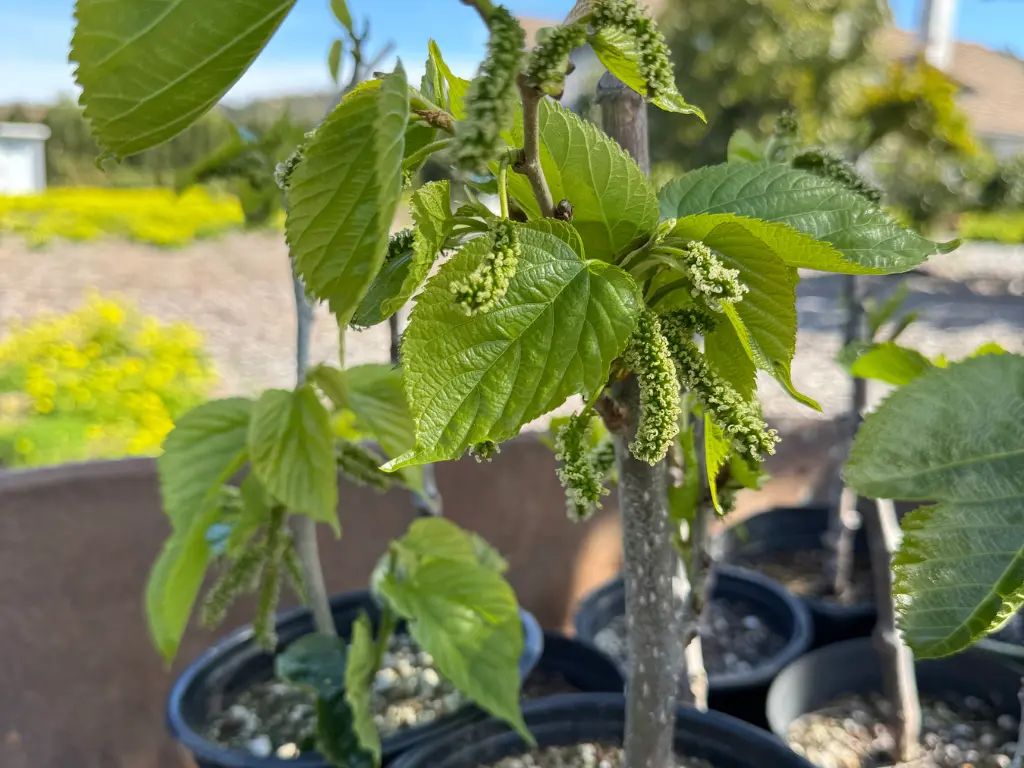
1. Choosing Your Planting Material
You can grow Pakistan mulberry from:
-
Bare-root or potted saplings: Best for home gardeners.
-
Cuttings: Effective if you’re propagating from an existing tree, though it requires rooting hormone and careful moisture control.
-
Seeds: Rarely used, as it takes longer to mature and does not always produce true to type.
For most gardeners, buying a grafted or rooted sapling from a reputable nursery is the easiest and fastest way to enjoy fruits.
2. Planting Steps
Here’s how to give your mulberry tree the perfect start:
-
Dig a hole twice as wide and just as deep as the root ball.
-
Loosen the roots gently if they’re pot-bound to encourage outward growth.
-
Place the tree in the hole so that the root crown (where roots meet the trunk) is level with the soil surface.
-
Backfill with a mix of native soil and compost, pressing lightly to eliminate air pockets.
-
Water thoroughly to settle the soil around the roots.
-
Mulch around the base (2-3 inches thick), keeping it a few inches away from the trunk to prevent rot. Mulching conserves moisture, suppresses weeds, and nourishes the soil as it breaks down.
Pro Tip: Plant your mulberry in a spot with enough space to grow, as mature trees can reach 30-40 feet tall and wide, though pruning can keep them smaller.
Caring for Pakistan Mulberry
Once your tree is planted, here’s how to keep it healthy and productive.
1. Watering
-
First year: Water deeply 1-2 times per week, ensuring moisture reaches the root zone (about 12-18 inches deep).
-
After establishment: Fairly drought-tolerant but benefits from regular watering during flowering and fruiting to prevent fruit drop and shriveling.
-
Tip: Check soil moisture by sticking your finger 2 inches into the soil; water if it feels dry.
2. Fertilizing
For robust growth and generous fruiting:
-
In early spring, apply a balanced fertilizer (e.g., 10-10-10) around the drip line.
-
Organic options: Compost, aged manure, or fish emulsion nourish the tree naturally while improving soil health.
-
Avoid over-fertilizing, which can lead to excessive leafy growth with fewer fruits.
3. Pruning
Prune in late winter while the tree is dormant to:
-
Remove dead, damaged, or crossing branches.
-
Open up the canopy for better air circulation and sunlight penetration, reducing disease risk.
-
Shape the tree to keep fruits within reach and maintain a strong structure.
Bonus Tip: If you want your mulberry as a shade tree, minimal pruning is needed. If growing mainly for fruit, annual pruning keeps harvests easy and abundant.
Harvesting and Uses
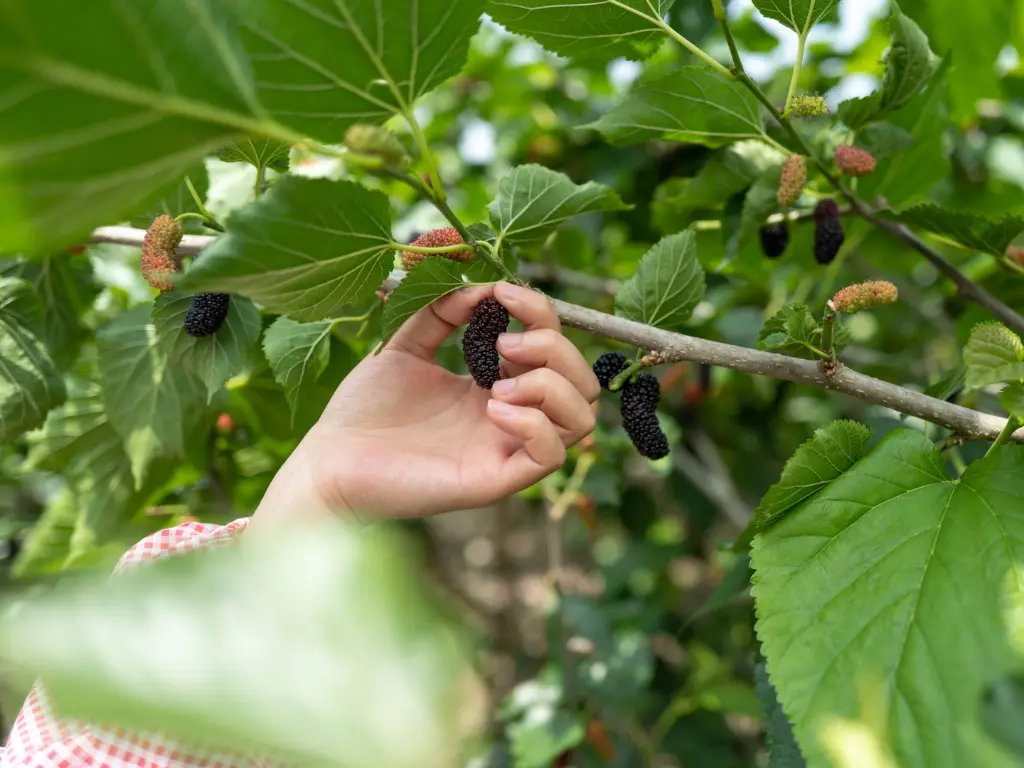
When to harvest: Late spring to early summer, depending on climate.
-
Fruits turn deep ruby-red to dark purple when ripe and come off easily with a gentle tug.
-
Harvest regularly to encourage continuous fruiting.
How to use your mulberries:
-
Fresh snacking (nothing beats the taste straight from the tree!).
-
Smoothies or juices.
-
Mulberry jam, syrup, or pie filling.
-
Drying for homemade trail mix or storing for winter use.
-
Freezing for year-round smoothies and baking.
Common Issues and How to Solve Them
-
Pests: Generally pest-free, but watch for occasional whiteflies, spider mites, or scale insects. Treat with insecticidal soap or neem oil if infestations appear.
-
Yellowing leaves: Often a sign of overwatering, poor drainage, or nutrient deficiencies. Adjust watering and check soil fertility.
-
Fruit drop: Usually caused by sudden drought stress or strong winds during fruiting. Water consistently and consider windbreaks if needed.
Pakistan Mulberry in Landscape Design
Beyond its fruit, Pakistan mulberry is a stunning landscape tree.
Shade tree: Large, spreading canopy perfect for patios, garden seating areas, or orchard rows.
Ornamental appeal: Beautiful serrated leaves and graceful branching add year-round beauty.
Edible landscaping: Combine with figs, pomegranates, or guavas for a lush, tropical edible garden.
Conclusion
Pakistan mulberry is a gardener’s dream – fast-growing, low-maintenance, and incredibly rewarding. With proper planting, sunlight, and minimal care, you’ll enjoy abundant harvests of sweet, luscious mulberries every year.
If you’re looking for a tree that provides beauty, shade, and baskets of nutritious fruits, give Pakistan mulberry a try. Follow the steps outlined in this guide, and soon you’ll be enjoying fresh mulberries with your morning coffee, drying them for winter snacks, or sharing overflowing harvests with your neighbors and friends.
Ready to add this extraordinary fruit tree to your garden? Plant it this season and look forward to years of sweetness, shade, and simple gardening joy.
You may like:

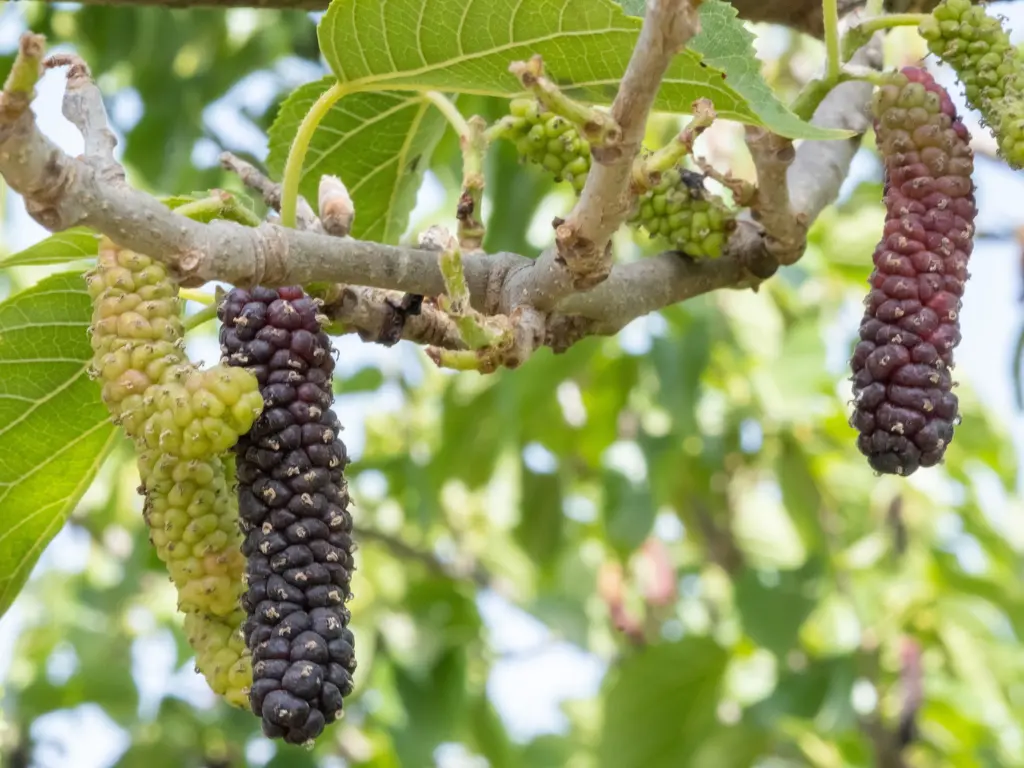
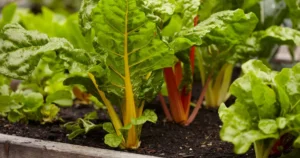
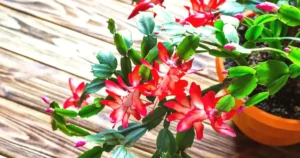
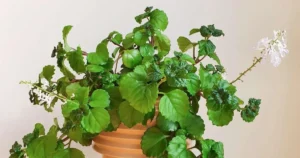
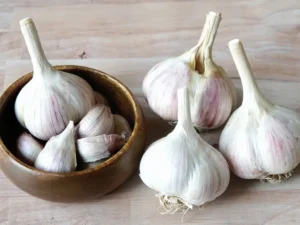

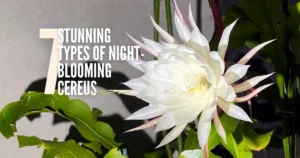
Would be helpful if one of many “complete” sites on paki mulberry would mention if they lose leaves in fall/ winter in zone 9. And, if they react negatively to certain sprays. Mine has rough brown areas on underside of leaves which can easily be detached from branch. This is not rust.